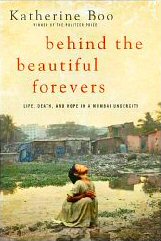No marriage is happy after it happens. It’s only before, thinking of it, that it’s happy.
– Manju’s drunkard father in Behind the Beautiful Forevers p.183
 I can’t swear it’s all non-fiction.
I can’t swear it’s all non-fiction.
But Behind the Beautiful Forevers: Life, Death, and Hope in a Mumbai Undercity by Katherine Boo is a devastating indictment of what is often proudly touted these days as “Rising India” or “Shining India.”
Kathering Boo, a staff writer with the New Yorker and spouse of an Indian academic Sunil Khilnani, spent several years writing this book, which broadly covers the 2008-2010 period.
India has hundreds of thousands of slums in metros like Mumbai, Delhi and Chennai where people live in unsanitary and inhuman conditions.
Behind the Beautiful Forevers is said to be a true account of the lives of some people in one such Indian slum.
Annawadi – A Mumbai Slum
For her book, Katherine picked Annawadi, one of the hundreds of slums dotting Mumbai, India’s largest city and a magnet for desperate migrants from across the country.
Located close to Mumbai’s international airport, Annawadi lies in the shadows of five-star hotels like Hyatt and Intercontinental.
The slum is named after Tamil migrants from South India who settled there first. Anna is a respectful Tamil word that refers to an older brother or any elderly person.
Every day, Tamils and other migrants make the long trek to Mumbai yearning for a better life and, if they’re not sleeping on the pavements and sidewalks, live in fetid slums.
Most of my readers are schmucks, forever lost in reveries of their lips tightly wrapped around a Bollywood hulk’s schlong or tongue down a Kollywood starlet’s twat, and will never pick up this 254-page book.
So let me summarize the book for you.
Behind the Beautiful Forevers is a close look at the hard struggle of a bunch of people in Annawadi to rise above their fetid surroundings.
Do they succeed in overcoming the countless obstacles the poor in Indian slums face every day?
The answer to that question is to be found in a line from the book,
For every two people in Annawadi inching up, there was one in a catastrophic plunge (p.24).
To all those who claim that a rising Indian economic tide will lift all boats, it just does not appear to be true.
At least, not the boats of India’s poorest in the slums.
Katherine weaves her account of Annawadi from the perspective of a few characters, principally the garbage sorter Abdul Hakim Hussain, the slumlord and politician wannabe Asha, her college-going daughter Manju, garbage picker Sunil and One-Leg Fatima.
But several other people (friends and relatives) and institutions (police, judiciary, hospitals etc) that impinge on the lives of the principal characters make frequent appearances to provide an all-round, vivid portrait of Abdul, Asha, Manju and Sunil and of the slum itself.
Life in Annawadi with the sewage lake, the goats, pigs, dogs and the buffalo expelling its shit on those nearby with a furious velocity is living hell.
And the people living squalid lives there are nothing but prey, often of other poor people on the same level or just a few rungs above.
Corrupt policemen, doctors in the hospitals, government employees, politicians and even other aspiring slum dwellers like Asha constantly prey on Annawadi residents.
That people like the garbage sorter Abdul Hussain or the garbage pickers like Kalu, Sanjay, Sunil or Sonu make it through a single day is itself nothing short of a miracle.
Ultimately, some of our acquaintances like the garbage pickers Kalu and Sanjay and the Tamil girl Meena die horrible deaths.
Nobody, not the charity organizations, not the police, not the government, not the social workers, not even the court, is a friend.
As Katherine writes of Abdul’s thoughts after One Leg’s fatal blow on the Hussain family:
The Indian criminal justice system was a market like garbage, Abdul now understood. Innocence and guilt could be bought and sold like a kilo of polyurethane bags (P.107).
As anyone familiar with India knows, even God has forsaken India’s poorest.
Fiction or Non-Fiction
I am skeptical that Behind the Beautiful Forevers is 100% non-fiction.
Why am I not sure if Behind the Beautiful Forevers is fiction or a much embellished non-fictional work?
First, Katherine Boo is a foreigner with nil or limited knowledge of Marathi, Hindi or Tamil, the main languages spoken in the Annawadi slum on which she writes.
Tis’ true that she employed translators and assistants but to see in print the thoughts of Abdul, Manju, Meena or other characters expressed in their words (standing by the toilet, during One-Leg’s immolation and other dark moments) is hard for my skeptical mind to swallow.
Second, I’ve never come across non-fiction accounts of poverty so richly and beautifully written.
By the way, the title Behind the Beautiful Forevers is drawn from an advertisement for Italian floor tiles on a concrete wall hiding the slum from travelers arriving at the airport.
Your favorite blog SearchIndia.com heartily recommends Behind the Beautiful Forevers with the near certainty that none of you will pick it up.

Katherine did a interview on her book, experience and writing while in India on NPR recently.
http://www.npr.org/2012/02/06/146463567/mumbai-slum-exists-behind-the-beautiful-forevers
I thought it was a pretty nice interview.
Also recently there was another book with a very similar theme whose author was also interviewed, can’t seem to find it now. Will post when I locate it.
Maybe there is a resurgence in writing about the depressing, seamy underbelly of India post slumdog millionaire.
SearchIndia.com Responds:
Good one.
Two interesting points from Katherine’s NPR interview:
Most definitely worth reading.
I think the New Yorker had an excerpt/essay from the book a few months back.